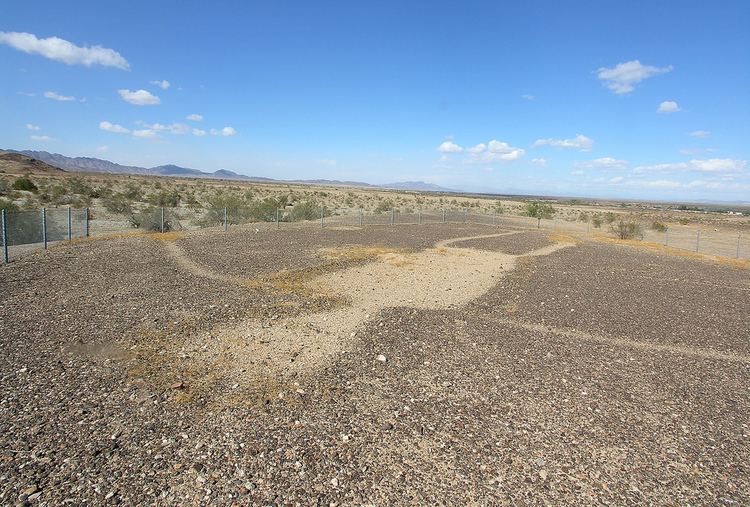CHISL # 101 Area 2.59 km² Added to NRHP 22 August 1975 | NRHP Reference # 75000452 Address Blythe, CA 92225, USA Phone +1 928-317-3200 Management Bureau of Land Management | |
 | ||
Similar Marree Man, Paracas Candelabra, Atacama Giant, Uffington White Horse, Cerne Abbas Giant | ||
Blythe intaglios aerial footage phantom2 gopro 3 geoglyphs
The Blythe Intaglios or Blythe Geoglyphs are a group of gigantic figures found on the ground near Blythe, California in the Colorado Desert. The intaglios are found east of the Big Maria Mountains, about 15 miles (24 km) north of downtown Blythe, just west of U.S. Highway 95 near the Colorado River. The largest human figure is 171 feet (52 m) long. The intaglios are best viewed from the air.
Contents
- Blythe intaglios aerial footage phantom2 gopro 3 geoglyphs
- Exploring giant ancient figures in the deserts of the blythe intaglios
- Rediscovery
- Topock Maze
- Figures
- Location
- References
The geoglyphs or intaglios (anthropomorphic geoglyphs) were created by scraping away layers of darker rocks or pebbles to reveal a stratum of lighter-valued soil. While these "gravel pictographs" are found through the deserts of southeastern California, human figures are found only near the Colorado River. The figures are so immense that many of them were not observed by non-Indians until the 1930s. The set of geoglyphs includes several dozen figures, thought to be ceremonial in nature. Many of them are believed to date from the prehistoric period, but their age and the identity of their creators are still uncertain. Jay von Werlhof and his collaborators obtained 13 AMS radiocarbon dates for the figures, ranging from 900 BCE to 1200 CE.
Exploring giant ancient figures in the deserts of the blythe intaglios
Rediscovery
In 1932, a pilot flying between Las Vegas, Nevada and Blythe, California noticed the Blythe geoglyphs. His find led to a survey of the area by Arthur Woodward, Curator of History and Anthropology at the Natural History Museum of Los Angeles County.
Topock Maze
The Topock Maze, another geoglyph site near Needles, California, covers 18 acres (73,000 m2) and consists of a series of parallel windrows approximately five feet apart.
Edward Curtis reported in 1908 that, "The Mohave Indians near by have utilized the area ... in recent years, as a maze into which to lure and escape evil spirits, for it is believed that by running in and out through one of these immense labyrinths, one haunted with a dread may bewilder the spirit occasioning it, and thus elude them." Similarly, an unpublished mid-20th century report cited second-hand ethnographic information that, prior to 1900, the "Mohave used to put some of their men in the center of the area of alignment and left them to find their way out of the maze without crossing the gravel alignments. By doing this they would leave the devil behind them."
However, Ruth Musser-Lopez reviewed historic and archaeological evidence concerning the "maze," finding strong support for the conjecture that the feature was originally created as a result of late-nineteenth-century gravel harvesting for railroad construction and thus unrelated to the Blythe geoglyphs.
Figures
Ethnographer Boma Johnson has tried to place the figures in context of Yuman oral history and cosmology. From this understanding, the figures portray mythic characters, and are often found where mythic events are thought to have occurred. One of the notable mythic figures is a 20- to 25- meter long humanoid figure located next to a second glyph, this of a quadruped resembling a mountain lion. Additionally, 18-foot (5.5 m)-tall figures bearing a likeness to Mastamho and Kataar, the "hero twins of the creation myth," can be seen near Fort Mojave in Arizona.
Of the nearly 60 sites containing humanoid figures, almost all of them have a deeply entrenched torso, while the limbs are much more shallowly etched into the surface. Often, the head and/or one or more arms of the figure will not have been represented at all. The largest human figure is 171 feet (52 m) long, while the smallest is 95 feet (29 m) long.
Location
The majority of the Blythe geoglyphs are located 16 miles (26 km) north of Blythe, California, off Highway 95, at the Interstate 10 exit and down several dirt roads for 15.5 miles (24.9 km). An historical marker placed by the California Department of Public Works, Division of Highways, commemorates the site. Chain link fences surround several of the figures. The intaglios were featured prominently in the Hardy Boys novel Mystery of the Desert Giant, published in 1961.
